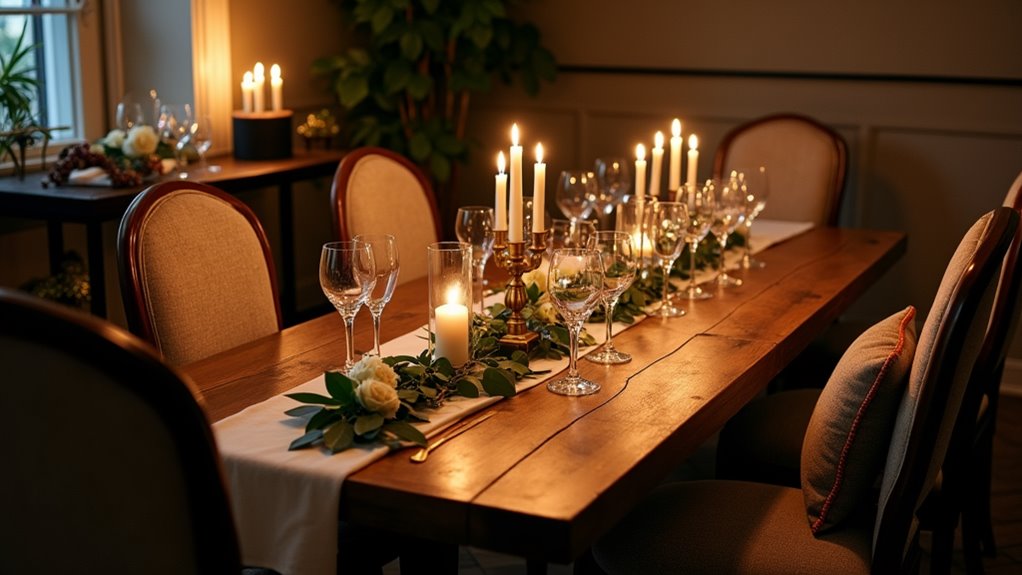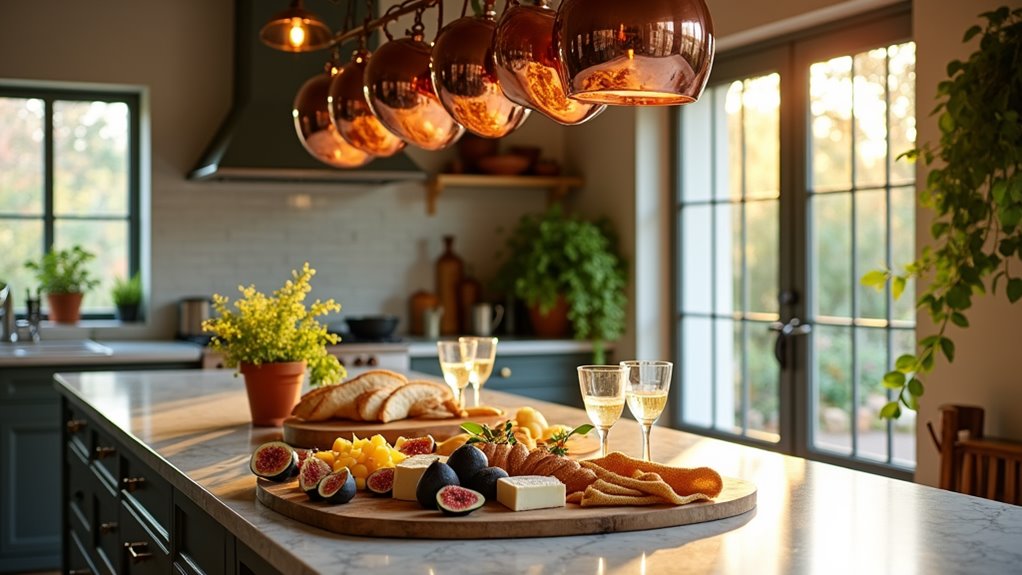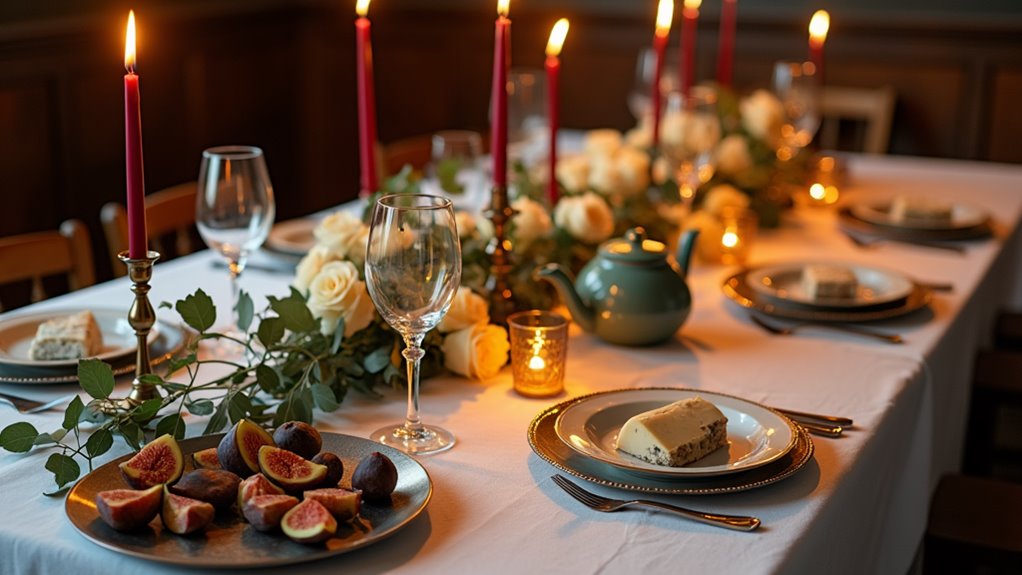You'll create a warm and inviting atmosphere for guests by focusing on key hospitality elements. Start with ambient lighting using table lamps and candles, then add soft background music that won't overpower conversation. Pay attention to thoughtful details like fresh flowers, scented candles, and comfort essentials in guest areas. Plan your menu and timeline in advance, prepping food early so you can focus on guests when they arrive. Keep the conversation flowing naturally by connecting guests with shared interests and having easy conversation starters ready. These foundational hosting skills will help you master the art of memorable entertaining.
Key Takeaways
- Create an inviting atmosphere through thoughtful lighting, soft music, and natural fragrances that enhance guest comfort without overwhelming senses.
- Anticipate guest needs by providing essential amenities, comfortable seating, and maintaining appropriate room temperatures throughout gathering spaces.
- Foster meaningful conversations by connecting guests with shared interests and guiding discussions to include everyone present.
- Add personal touches like fresh flowers, welcome notes, and favorite beverages to make guests feel specially welcomed.
- Prepare thoroughly in advance, from menu planning to setup, allowing yourself time to be present and relaxed with guests.
Setting the Perfect Ambiance

When hosting guests in your home, the right ambiance can transform an ordinary gathering into a memorable experience.
Start by adjusting your lighting – dim overhead fixtures and add soft, warm lighting through table lamps and candles.
Consider your music selection carefully, keeping the volume low enough for comfortable conversation while matching the mood of your gathering.
Temperature plays a crucial role too – keep your space comfortably cool, as groups tend to warm up a room quickly.
Add fresh flowers or greenery for natural beauty, and ensure your space is clutter-free and well-arranged for easy movement.
You'll want to pay attention to scent as well – a light, natural fragrance from candles or essential oils can enhance the atmosphere without overwhelming your guests.
Essential Party Planning Tips
Although party planning can feel overwhelming, breaking it down into manageable steps will help you create a successful event. Start by setting your date, guest count, and budget at least three weeks in advance.
Create your guest list and send invitations two weeks before, requesting RSVPs to help with planning.
Develop your menu based on the event's timing and style, considering any dietary restrictions. Make a detailed shopping list and timeline for food preparation.
You'll want to prep as much as possible the day before. Don't forget to plan your beverage service, including non-alcoholic options.
Create a music playlist, ensure you have enough seating, and stock up on ice.
On party day, give yourself ample time to set up and get ready before guests arrive.
Creating Unforgettable Menu Combinations

When you're planning your menu, you'll want to start with fresh, seasonal ingredients that naturally complement each other and showcase the best flavors of the moment.
You can create perfect pairings by matching lighter dishes with more substantial ones, such as crisp salads with hearty mains, or bright citrus desserts with rich appetizers.
The key to an unforgettable menu lies in striking the right balance of flavors and textures throughout your courses, from tangy to sweet, and from creamy to crunchy.
Seasonal Ingredients Shine Bright
Seasonal ingredients transform ordinary dinner parties into extraordinary culinary experiences. You'll discover that planning menus around what's naturally available helps create more vibrant, flavorful dishes while keeping costs down.
In spring, showcase tender asparagus and sweet peas. Summer calls for heirloom tomatoes and fresh herbs from your garden. Fall brings hearty squashes and crisp apples, while winter's root vegetables add warmth to your table.
When you're selecting ingredients, visit local farmers' markets to find the freshest options. You'll notice how peak-season produce requires minimal preparation to shine.
Let nature's timing guide your menu planning, and you'll create memorable meals that reflect the essence of each season. Your guests will appreciate the thoughtful connection between your dishes and the time of year.
Perfect Pairings Every Time
Building on your fresh, seasonal ingredients, creating harmonious menu combinations elevates your dinner party from a simple meal to a cohesive culinary journey.
Consider flavor profiles, textures, and temperatures when planning your courses. A crisp salad with citrus vinaigrette prepares palates for richer main dishes, while a velvety soup pairs beautifully with crusty artisanal bread.
Match your wine selections to complement, not overpower, your dishes. Light whites enhance delicate fish courses, while full-bodied reds stand up to hearty meats.
Don't forget the importance of contrast – sweet against savory, smooth against crunchy. For dessert, balance rich chocolate with fresh berries or pair warm apple tart with cool vanilla ice cream.
Balance Flavors and Textures
Success in menu planning hinges on mastering the interplay between contrasting and complementary elements. You'll want to pair crispy with creamy, light with rich, and sweet with savory to create memorable dining experiences.
Consider serving a silky butternut squash soup with toasted pumpkin seeds, or match tender braised short ribs with crunchy roasted vegetables.
Don't forget about temperature variations – a warm apple crisp alongside cold vanilla ice cream creates an exciting sensory experience.
When planning your courses, think about how each dish's flavors build upon or contrast with others. A citrusy salad can cleanse the palate before a rich main course, while a spicy appetizer might lead naturally to cooling elements in subsequent dishes.
Your goal is to keep guests' taste buds engaged throughout the meal.
Thoughtful Guest Comfort Details
When you're hosting guests, you'll want to consider their essential needs by placing water carafes in bedrooms, setting out fresh towels, and ensuring easy bathroom access.
Create dedicated spaces where guests can unwind privately, like a cozy reading nook or a well-appointed guest room with charging stations and Wi-Fi information.
The extra touches that show thoughtfulness – like fresh flowers, personalized welcome notes, or their favorite morning beverages – will make your guests feel truly valued and at home.
Anticipating Their Essential Needs
How can you ensure your guests feel truly comfortable and cared for during their visit? Start by anticipating their basic needs before they arrive. Stock your bathroom with fresh towels, extra toilet paper, and basic toiletries.
Keep spare phone chargers, reading glasses, and over-the-counter medications readily available.
Consider dietary restrictions and preferences by asking ahead of time. Have light snacks, drinking water, and beverages easily accessible. Ensure good lighting in guest areas and provide clear wifi access information.
Keep extra blankets and pillows within reach, and maintain a comfortable room temperature.
For overnight guests, prepare their space with essential items like tissues, a wastebasket, and a small clock. Remember to share important details like your home's quirks or security system codes they might need.
Create Welcoming Personal Spaces
Making your guests feel at home requires creating personal spaces that offer both comfort and privacy. Set up guest rooms with essential amenities like fresh towels, extra blankets, and reading lights.
Include thoughtful touches such as bedside water carafes, charging stations, and small fans for temperature control.
If you don't have a dedicated guest room, transform a corner of your home into a cozy retreat. Provide portable privacy screens, comfortable seating, and designated storage space for your visitors' belongings.
Add personal touches like fresh flowers, magazines, or local guidebooks to help them feel welcomed and oriented.
Remember to respect your guests' need for alone time by establishing clear boundaries between shared and private spaces. This balance helps everyone feel more relaxed and at ease.
Extra Touches Matter Most
The smallest details often create the most memorable guest experiences. Consider placing fresh flowers in the guest bathroom, setting out plush hand towels, and ensuring there's extra toilet paper within easy reach.
Stock a bedside carafe of water and glasses for overnight visitors.
You'll want to think about comfort from your guests' perspective. Keep extra blankets visible and accessible, provide clear wifi login instructions, and ensure adequate lighting for reading or navigating at night.
Set out basic toiletries they might've forgotten and include simple luxuries like scented hand soap or quality tissues.
Don't forget practical items like phone chargers, hangers, and a small wastebasket in their room. These thoughtful touches show you've anticipated their needs and truly want them to feel at home.
Seamless Conversation Flow

Since successful hosting relies heavily on guest interaction, maintaining smooth conversation flow throughout your event can make or break the atmosphere.
You'll want to guide discussions naturally while ensuring everyone feels included. Keep topics light and accessible early in the gathering, then let conversations develop organically as guests become more comfortable.
Watch for guests who seem left out and draw them in with questions about their interests or experiences. If you notice a conversation becoming heated or uncomfortable, gracefully redirect it to neutral ground.
When you need to step away to tend to hosting duties, connect two guests with a shared interest first. They'll likely maintain the dialogue while you're gone, keeping the social momentum going.
After-Party Success Strategies
While your guests are heading home, smart hosts know the party isn't truly over until everything's back in order. Start by gathering perishable foods first – they'll need immediate refrigeration to stay fresh.
Sort recyclables from trash and dispose of them properly.
Don't wait until morning to tackle the dishes. At minimum, scrape plates and load the dishwasher, then soak pots and serving pieces that need hand-washing.
Wipe down counters and tables to prevent stains from setting.
Pack away decorations and rearrange furniture to its original position. Open windows briefly to air out cooking odors and refresh the space.
Make quick notes about what worked well and what you'll do differently next time – your future self will thank you for this valuable feedback.
Frequently Asked Questions
How Do I Politely Ask Guests to Leave When the Party's Over?
You can wrap up a party naturally by giving subtle cues: start cleaning up, turn down the music, mention the time, or bring up early commitments the next day.
If needed, say something like "It's been wonderful having you, but I should start winding down" or "I've really enjoyed tonight, but I've got an early start tomorrow."
Most guests will take these hints gracefully.
What Should I Do if Guests Bring Uninvited Plus-Ones?
When unexpected plus-ones arrive, stay gracious in the moment and welcome them to avoid creating an awkward situation.
You'll want to discreetly accommodate them, even if it means adjusting food portions or seating arrangements.
For future events, be explicit about guest limits on invitations, and if someone asks to bring an extra person, you can politely explain your space or planning constraints.
How Can I Handle Dietary Restrictions I Learn About Last-Minute?
Like a skilled chef who can whip up magic from pantry staples, you can handle last-minute dietary curveballs.
Keep versatile ingredients on hand, such as rice, beans, fresh vegetables, and fruits. You can quickly modify existing dishes by serving sauces or toppings separately.
If needed, create a simple dish using these basics, or turn to delivery services for specialized meals. Don't forget to note these restrictions for future gatherings.
What's the Best Way to Decline Hosting When Someone Invites Themselves Over?
When someone invites themselves over, be direct but polite. You can say, "I'm sorry, but tonight/today doesn't work for me."
If you want to maintain the relationship, suggest an alternative time that suits your schedule better.
Don't feel obligated to explain or make excuses – a simple, firm response is enough.
How Do I Manage Guests Who Drink Too Much at My Gatherings?
Like a captain steering a ship through stormy waters, you'll need to navigate this situation carefully.
When you notice someone's had too much, quietly switch their drinks to water or soda, and keep food readily available.
You can also plan ahead by serving drinks yourself instead of having an open bar, setting clear end times for your gathering, and arranging rideshare options before the party starts.
Conclusion
Like Martha Stewart meets Marie Kondo, you've now mastered the art of creating joy through hospitality. You'll find that each gathering becomes easier as you build your entertaining expertise. Remember, just as Dorothy discovered there's no place like home, your space can become that magical setting where memories bloom. Trust your instincts, keep it simple, and watch as your home becomes everyone's favorite destination.

Leave a Reply